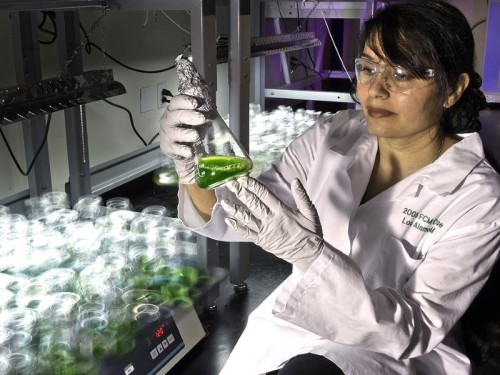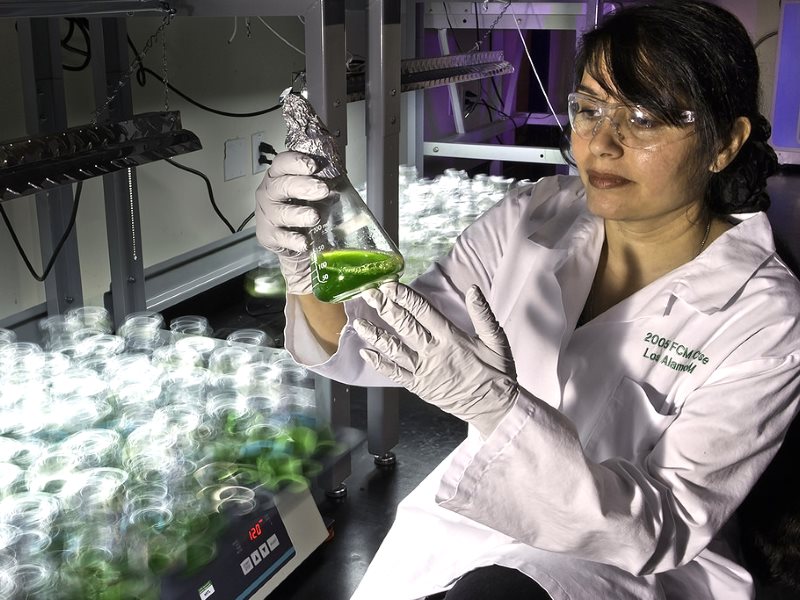
by Almuth Ernsting, Ecologist
The biofuels of the future will depend on microbes, writes Almuth Ernsting: algae to produce the biomass, and fungi or bacteria to break cellulose down into useful molecules. Just one problem: wild strains aren’t up to the job. So scientists are trying to genetically engineer supercharged ‘synthetic biology’ variants – which will inevitably enter the environment. What could possibly go wrong?
In the UK, the use of genetically engineered (GE) microbes in biofuel production is approved by the Health and Safety Executive, which has seen its budget slashed by 40% since 2010.
In the US, such supposedly ‘contained’ use of GE microbes is waved through by the Environmental Protection Agency without any risk assessment.
And up against these weak or under-resourced regulators are some of the world’s biggest and most powerful companies, developing or using genetically engineered microbes for biofuel production.
Among them are big biotech firms including DuPont and Novozymes, energy corporations such as Abengoa and BP, and synthetic biology companies such as Amyris, Solazyme, Joule and Gevo.
Most policymakers and international organisations have finally accepted that biofuels made from oil palm or soya plantations or from cereals are not such a great green idea as many had thought a decade ago.
Earlier this year, the EU decided to cap the amount of biofuels made from food and feed crops, although the cap still allows for an increase in the use of such biofuels. Most biofuel advocates claim that the future lies in ‘next generation’ biofuels – made from solid (‘cellulosic’) biomass or from algae.
So far, it’s been a commercial failure
Much of the debate about next generation biofuels has focused on the sustainability of the potential feedstocks. If there was any prospect of commercial cellulosic biofuel production in the near future, such a debate would clearly be a high priority. After all, feedstocks which could be used to make cellulosic biofuels are precisely those suitable for biomass power stations.
The environmental, social and climate impacts of the latter have turned out to be far from benign. There is every possibility that a new potentially vast market for wood and crops grown in monocultures would lead to more deforestation and forest degradation, more land-grabbing and more competition with food production. And excessive removal of agricultural residues for biofuels would worsen soil degradation.
In reality, the prospects of large quantities of cellulosic or, for that matter, algal biofuels being produced any time soon seems remote. But this isn’t because developers can’t turn wood into ethanol or diesel, nor because they can’t extract and refine algal oil.
The world’s first wood-to-ethanol plant opened in North Carolina 104 years ago. Nazi Germany operated 25 plants which turned coal into diesel in a process which can also be used with biomass. As for algae, extracting the oil they produce and refining it to biodiesel is not technically challenging.
The big challenge, and one which nobody seems to have overcome yet, is finding a way to produce such biofuels efficiently – without exorbitant costs and without expending excessive amounts of energy on refining, or on growing and harvesting algae.
Some commercial-scale cellulosic biofuel refineries have been opened, backed by hundreds of millions of dollars of public funds. Several have closed down after unsuccessful start-ups, resulting in the bankruptcy of at least four companies.
Seven remain officially open. Four of those are in the US and figures published by the Environmental Protection Agency show that during the first seven months of the year, they ran at just 3.7% of their combined capacity.
Two other plants are in Brazil and one is based in Italy but no independent figures have been published to indicate how much fuel, if any, those have been producing.
Plant cell walls are incredibly tough and indigestible
The key reason for the failure of cellulosic biofuels is simple: Over 540 million years of plant evolution, living plants have had to protect themselves from being eaten by animals or digested by microbes.
Plant cell walls have developed highly complex and recalcitrant chemical structures that render the sugars in cellulosic biomass largely inaccessible to most of the organisms that would otherwise make a meal of them.
There are many different kinds of sugars in cellulosic biomass, and no single microorganism can access all those and then ferment them. Breaking down the structures of the cell walls to access sugars using heat, pressure and chemicals requires a lot of energy and is only partly effective.
Most researchers and companies therefore rely on microbes for both steps: to break down the cell walls and access sugars, and also to produce enzymes that ferment the sugars. The sheer number of different enzymes needed to digest different types of sugar makes the whole process, costly, complex and thus impossible to scale up using existing ‘wild’ microbes that have not been genetically engineered.
Some have tried to make cellulosic biofuels without using microbes, relying instead of heat and chemical catalysts, a process similar to Nazi Germany’s synthetic diesel plants.
All attempts to do so reliably and without excessive energy inputs have failed. In fact the US government has limited their research and development programme for such technologies to coal-to-liquids, with at most a small proportion of biomass being mixed with the coal.
Wild strains aren’t up to the job. Enter synthetic biology
Cellulosic biofuels thus rely on synthetic biology: that is, on attempts to engineer microorganisms with a fundamentally different and new metabolism. The genetic engineering involved is far more radical than that used for existing GMO crops.
Biotech companies and researchers seem to be a long way from engineering a ‘super-microbe’ which can efficiently turn solid biomass into liquid fuels – or even from engineering several microbes so that a few together could produce commercially viable cellulosic biofuels.
The quest for such GE microbes relies on trial and error: Some companies are engineering thousands of different strains of GE bacteria or yeast cells in laboratories, investigating them for their properties and then culturing those that appear desirable for biofuel production.
The chosen GE microbes may then be trucked and shipped across large distances and some will be used directly inside biofuel refineries. Companies claim that their GE microbes are safely contained – both physically, inside laboratories, enzyme production plants and refineries, and biologically, through gene changes meant to stop them from replicating or surviving in natural environments.
But as a report by the Secretariat of the UN Convention on Biological Diversity (CBD) highlights, both forms of containment are far from reliable. And using GE microbes in an industrial plant, staffed by engineers and refinery operators with no background in microbiology and biosafety is very different from keeping them in a biotech laboratory.
Algal biofuel developments, too, rely on synthetic biology: No species has been found which combines all of the traits needed for efficient algal biofuel production, i.e. high growth rates and oil yields, ability to thrive in waste water and without too many fertilisers, and the ability to defend themselves from being eaten and outcompeted by other microorganisms in open ponds.
Biotech companies are, for example, engineering algae to produce a wide range of antibiotics and other anti-microbials to protect themselves and to be able to outcompete other microbes. Those traits are associated with invasiveness, i.e. with the ability or organisms to rapidly spread in natural environments.
In the case of GE algae grown in open pond systems, there cannot even be a pretence of physical containment.
Known unknowns. And unknown unknowns
How dangerous would the escape of GE microorganisms be? Back in 1999, a study by researchers from Oregon State University caused alarm: they had investigated the effects on soils and plants of a bacterium genetically engineered to ferment biomass into ethanol and mineral sludge.
In their pot experiment, all wheat plants grown in soil with the GE microbe died, and all those grown without it survived. It was a troubling finding, with one reporter writing that the GE bacterium could have wiped out all life on earth had its release not been stopped.
In reality, nobody can credibly predict what would have happened had it been released. On the one hand, the diversity and abundance of microorganisms is thought to be far greater than that of larger species and high species diversity provides a degree of protection against alien invasive species.
On the other hand, studies looking at non-GE E.coli contamination of soils reveal that when soil microbial diversity is diminished, alien microbes can much more easily assert themselves. The risk of GE microbes proliferating in soils depleted by decades of industrial agriculture may thus be higher than they would be in healthy soils.
Yet all of this remains conjecture: Since the 1999 study, there has been virtually no research into the potential ecosystems impacts of GE microbes. Overall, little is known about the functioning and composition of soil microbial communities. Only around 1% of soil microorganisms have ever been cultured and viewed under a microscope.
There are three reasons why the risks posed by GE microorganisms are particularly troubling:
- Microorganisms proliferate and evolve much faster than multi-cell organisms.
- Bacteria and yeast can pass genes on to entirely different species, sometimes even to plants and animals. Such ‘horizontal gene transfer’ is the reason why antibiotic resistance has spread so rapidly.
- Microbial communities, including microalgae, are the basis for all life on earth: they recycle nutrients and carbon, and they produce much of the oxygen we are breathing.
Once used in an industrial context, GE microbes are impossible to contain, trace and monitor. Supporting new biofuel technologies which depend on their development and use is thus incompatible with the precautionary principle.
